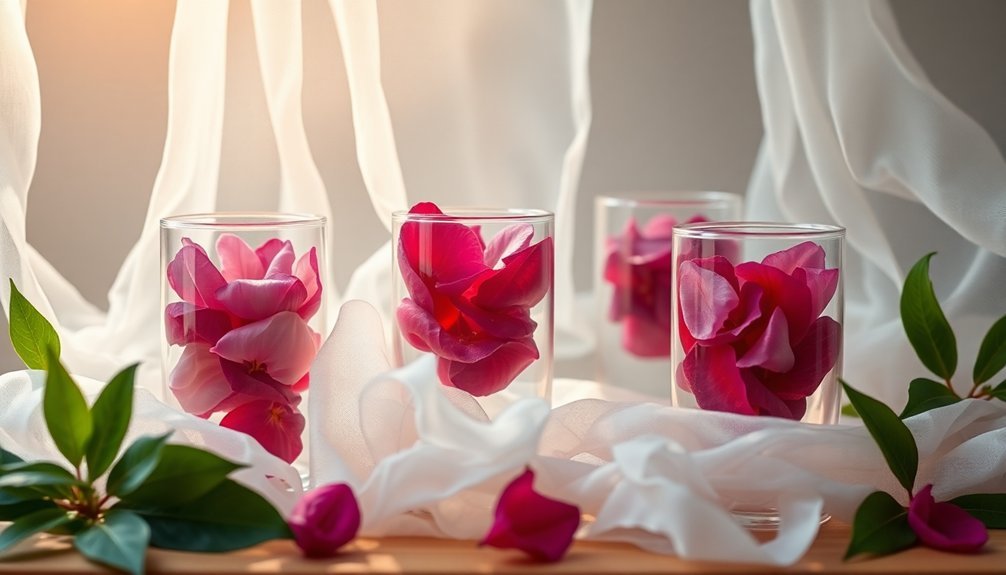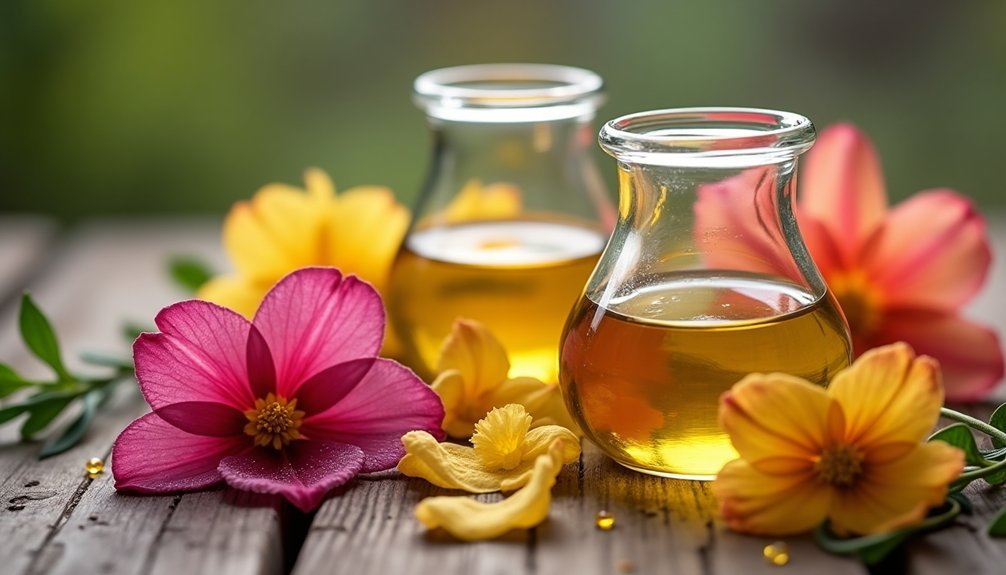Three proven cold extraction methods will help you capture pure floral oils without heat damage. Cold enfleurage uses odorless fats to absorb delicate flower essences over time, while cold pressing efficiently extracts oils from citrus peels through mechanical pressure. CO2 extraction utilizes pressurized carbon dioxide to gently dissolve aromatic compounds from flower petals. Each technique preserves the true essence of your botanicals – there's an artful science behind these time-tested methods waiting to be explored.
Mastering The Gentle Art Of Enfleurage

When you're working with delicate flowers like jasmine, daffodil, or violet, cold enfleurage offers the gentlest method of extracting their precious oils.
You'll need glass trays, odorless fat, and fresh flowers to begin this meticulous process.
Start by spreading a thin layer of your chosen fat, such as coconut or babassu oil, onto glass plates. Place clean, dry flowers onto the fat, leaving space between each bloom for ideal absorption.
You'll need to replace these flowers daily until your fat reaches the desired fragrance intensity. This process was first perfected in Grasse, where French perfumers elevated it to an art form. Once saturated, cleanse the perfumed fat with alcohol to obtain the pure essential oil.
While this traditional technique is labor-intensive, it captures the true essence of living flowers without heat damage.
Modern perfumers often opt for faster methods, but cold enfleurage remains unmatched for preserving delicate floral fragrances.
The Science Behind Cold Pressing Citrus Oils
Moving from the gentle art of enfleurage, cold pressing stands as another effective method for capturing natural oils – particularly from citrus fruits.
You'll find this technique especially fascinating as it preserves the vibrant essence of citrus peels without using heat, ensuring the oils retain their natural aroma compounds and nutritional benefits.
When you observe a cold pressing operation, you'll notice these distinct elements:
- Rotating spikes puncturing fresh citrus peels with precision
- Clear oil droplets emerging from ruptured glands
- Centrifuges spinning to separate pure oil from water
- Modern machines adjusting automatically to different fruit types
The process, first developed in 19th century Italy, has evolved into a sophisticated operation that you can control through electronic calibration and real-time monitoring, ensuring consistent quality in every batch of extracted oil.
This extraction method is remarkably efficient, yielding approximately 1 kg of oil from 200 kg of citrus peels.
Modern CO2 Extraction For Delicate Blooms

As botanical extraction technology has evolved, CO2 extraction has emerged as a revolutionary method for capturing the essence of delicate flowers. You'll find this process uses pressurized carbon dioxide in its supercritical state to gently penetrate flower petals and dissolve their aromatic compounds.
What makes CO2 extraction special is its ability to preserve fragile floral notes that might be damaged by traditional methods. The process works at lower temperatures than steam distillation and doesn't leave behind any solvent residues.
You're left with pure, potent oils that maintain the flower's natural properties. This eco-friendly method is perfect for extracting oils from sensitive blooms like jasmine, lilac, and elder flower. The closed-loop system ensures maximum recovery of essential compounds while eliminating unwanted impurities.
You'll appreciate how the resulting extracts maintain their therapeutic benefits while offering enhanced aroma and purity for aromatherapy, skincare, and natural perfumery applications.
Frequently Asked Questions
How Long Can Cold-Extracted Essential Oils Be Stored Before Losing Potency?
You'll find most essential oils last 3-5 years when stored properly. Keep them in dark glass bottles at 5-30°C, away from light. You should check regularly for changes in smell or appearance.
Can Cold Extraction Methods Be Safely Performed at Home?
You can safely perform cold extraction at home, but it's best to start with citrus oils. You'll need basic equipment like dark glass containers and cheesecloth, and must follow proper safety guidelines.
Why Do Some Flowers Yield More Essential Oil Than Others?
You'll find that oil yield varies between flowers due to their physical structure, oil gland distribution, and environmental growing conditions. Some species naturally produce more oil-containing cells in their tissues than others.
What Temperature Range Is Considered "Cold" for Extraction Purposes?
You'll find that "cold" extraction typically means temperatures below 49°C (120°F), but it varies by material. For delicate oils like extra virgin olive oil, you'll need to stay under 25°C, while jojoba tolerates 45°C.
Does the Season of Harvest Affect Cold Extraction Results?
Yes, you'll find that harvest season greatly impacts your extraction results, affecting oil concentration, plant maturity, and moisture content. It'll influence processing time, yield quality, and overall extraction efficiency.
In Summary
You've now learned three effective methods for extracting pure floral oils without heat damage. Whether you're drawn to traditional enfleurage's gentle touch, cold-pressing's simplicity, or CO2 extraction's modern precision, you'll be able to preserve your flowers' most delicate compounds. Start with small batches to perfect your technique, and you'll soon create aromatic oils that retain their natural essence and therapeutic properties.





Leave a Reply